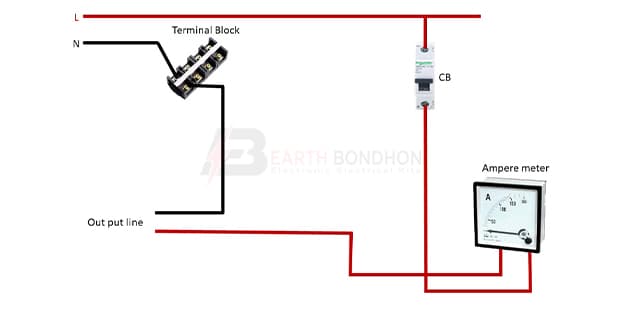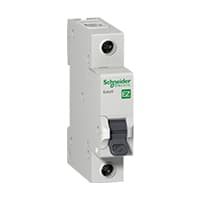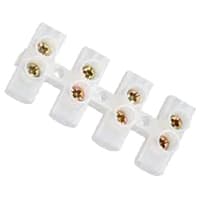Single Phase Ampere Meter Connection:
This diagram shows how to make Single Phase Ampere Meter Connection. In this circuit, we use a single-phase ampere meter, an SP MCB ( Single Phase Miniature Circuit Breaker ), and a terminal block. First, we need to input phase connection to the SP MCB, then input phase connection to the ampere meter, then input connection to the load from the ampere meter. Now this circuit is ready for use. If you want to know more about this circuit please check our youtube video below the post.
Advertisements
Components needed For this Project:
You can get the components from any of the sites below:
- Single Phase Amperemeter [See Buy Click Amazon]
- SP MCB 10A [See Buy Click Amazon]
- Terminal Block [See Buy Click Amazon]
*Please note: These are affiliate links. I may make a commission if you buy the components through these links. I would appreciate your support in this way!
Advertisements
Components used to make the Single Phase Ampere Meter Connection:
Ammeter, an instrument, with the help of which the flow of electricity can be measured directly in Electrical units, amperes. It is a galvanometer with very low resistance. As a result, the entire current flows through the meter coil. Current is measured with an ammeter. So it can be said that the device that measures the flow of current in an ampere unit is an ammeter. Electric current is the flow of electrons whose unit is an ammeter. So it can be said that the device that measures the flow of current in an ampere unit is an ammeter. An ideal ammeter has no internal resistance. But in reality. the ammeter has little internal resistance. The range of the ammeter depends on this resistance.
02. SP MCB:
In single-pole MCB, Switching and protection are Affected in only one Phase. Single phase supply to break the phase only. A single Pole breaker is Typically used with 120-volt Circuits, and a 6-20 amps Miniature Circuit Breaker. They are constructed with one Line Wire and one Neutral wire. A Single Pole switch is the most basic General-Purpose switch that you use to Control a light or another device from one location. These Switches have 2 Brass-Colored screw Terminals Connected to the hot Power source wires. Pole refers to the number of Circuits Controlled by the Switch SP Switches Control only one Switch Electrical Circuit.
Terminal Clocks are Connectors That Terminate a Single wire and Connect it to a circuit or other system. Terminal Blocks come in a range of shapes, Sizes, and ratings, but Always Terminate a single Wire and are Never multi-pole. Terminal Blocks are used to Secure or Terminate Wires and, in Their Simplest form, Consist of Several Individual Terminals Arranged in a long strip system. Terminals are Useful for Connecting the Wiring to the GND or, in the Case of Electrical power, for Connecting Electrical Switches and Outlets to the Mains side.
Thank You for visiting the website. Keep visiting for more Updates.
Frequently asked questions
An ammeter is a device or instrument that measures the amount of current flow passing through a circuit. An Ammeter is connected in series with the circuit to measure its current flow. We know, the flow of current flow will be the same in a series combination, but in the case of parallel combination, current is divided into branches.
One obvious example was the ammeter in an automobile. It not only shows how much current is flowing in the car's circuitry, but it also shows whether the battery is charging or being discharged, and to what degree. Another use of ammeters is to diagnose over-current conditions in a circuit.
The most important thing to remember was that an ammeter must be connected in series with the light of the bulb. This means that you must break the circuit to add an ammeter. That is, you must disconnect a lead or two to use an ammeter in a circuit.
Ammeters measure the amount of current in a circuit diagram, while voltmeters measure the potential difference or voltage between two points in a circuit diagram.
An ammeter is connected in series in a circuit as it measures the current flowing through the component whereas a voltmeter is connected in parallel as it measures the voltage across the two ends of the conductor.
Read more Single Phase Wiring
What is a kilowatt-hour (kWh) | kwh formula | What does kwh mean
Introduction to Electrical Units and CircuitskW and kWh on your electricity bill As your home uses electricity during...
What is the Difference Between kVA | What does KVA mean | kVA formula
Difference Between KVA ExplainedWhat does KVA Mean? There are technical terms aplenty when it comes to generators, and...
Power Factor | Power Unit | Energy | Electricity Unit
Power factor definition | Calculating Power FactorPower Factor Values In a purely resistive circuit, the power factor...




0 Comments